A beautifully situated red alpine hut, and a majestic long-drop with views over the surrounding mountains and glaciers, is the reward for the steep climb to French Ridge Hut (the track was made by climbers and you can certainly tell).
Length: 16.2km one-way with over 1000m elevation gain
Time taken: 3 days (day one to Aspiring Hut; 2 hours, day two to French Ridge Hut; 5 hours, day three return to carpark; 7.5 hours). Do-able in two days for fit people.
Difficulty: easy to Aspiring Hut and Pearl Flat, then difficult to French Ridge Hut (read: steep, steep uphill)
Facilities: Raspberry Creek carpark has a shelter and long-drop toilets. Aspiring Hut and French Ridge Hut are both New Zealand Alpine Club (NZAC) huts. Tou can pay for hut tickets ($30 and $25 per person respectively) at the DOC Centre in Wanaka or to the ranger at Aspiring Hut in season (late November – April). Aspiring Hut is a 33 bunk historic hut with gas, flush toilets, lighting and a fireplace in season. French Ridge Hut is a 20 bunk alpine hut with lighting, one long-drop toilet, and water tank on the deck of the hut (no heating available).
Gear list is at the bottom of the page.
– Important: I did this tramp in early autumn – conditions will be dramatically different in winter, spring or summer. Always check the forecast and go prepared for what conditions you’ll encounter. –
Why French Ridge Hut?
I may or may not have seen photos of the long-drop toilet next to French Ridge Hut and vowed to make the trip. I mean. It’s pretty glorious.

I’d walked in to Rob Roy Glacier a few times before. I’d always wondered what was further up the West Matukituki valley. Turns out it’s tussocked river flats framed by soaring snow-capped mountains with glaciers hanging from their slopes. Not a bad place to tramp into! My dad hadn’t been further than Aspiring Hut before. So as the week of Easter + Southland Anniversary Day + ANZAC day approached, we planned the trip.
How to get to French Ridge Hut trailhead
Raspberry Creek carpark is just over an hour’s drive from Wanaka, but it’s not the most straightforward of roads. Head west from Wanaka on Wanaka-Mt Aspiring Road past the famous/infamous Wanaka tree, Rippon vineyard, Glendhu Bay and the turn-off to Treble Cone ski-field. As the road gets closer to the carpark, it turns to gravel and has numerous unbridged fords. So depending on the amount of recent rainfall or snow melt (and experience of the driver), it might not be appropriate for low 2WD vehicles.
Drive to your experience and comfort level, and if you’re going slow, let others pass. We saw quite a few rental cars in the carpark, but not all rental car companies allow their cars on the road past Treble Cone. There is a shuttle service that runs in the summer. And there are various other shuttles that you can charter in the Wanaka area as well.
Raspberry Creek carpark is also the trailhead for the Rob Roy Glacier walk, a very popular and pretty day walk into Mt Aspiring National Park. As such, the carpark can fill up quite quickly on a good weather day (despite how much it’s been enlarged). So get there early if you don’t want to have to park down the road.
Day One: Raspberry Creek carpark – Aspiring Hut
The weather wasn’t looking too good for the first two days of the trip, but due to a prior commitment (shoutout to the beautiful Mr and Mrs Armstrong!) I couldn’t wait any longer for a weather window. In the end I’m glad we didn’t wait. Due to the public holidays it was pretty manic on our way out once the sun had started shining.
We arrived at Raspberry Creek carpark at around 11am to low, dark clouds and rain. We got all of our wet weather gear out, put it on, and repacked our bags in the shelter, while the rain set in. The tourists milling around waiting to see if the weather cleared looked at us as though we were crazy. I guess they weren’t wrong.
It was the type of weather where each footstep squelches into the sodden ground and pushes up splashes of water. That, and the handful of unbridged fords, meant that I soon gave up any attempt at keeping my boots dry (not ideal for day one of a three day trip). There wasn’t any shelter. So it wasn’t until Cascade Hut (a locked NZAC hut, 20 minutes from Aspiring Hut) that we took a proper break and I could take the only photo from that day. In the summer the lack of cover would mean no respite from the hot sun. Other than the many beautiful looking swimming holes in the river along the way (which weren’t quite tempting enough in the cold rain).

The walk in to Aspiring Hut is a pretty easy and flat 2 & a bit hours. Mostly following a 4WD track (although not the whole time, be careful to follow the orange trail markers when the path forks off from the road a few times). Sadly no trucks passed us. So when we caught our first glimpse of Aspiring Hut from under our rain-jacket hoods, it was with great relief to see smoke coming from the chimney. There were a pair of climbers sheltering in the hut. They’d spent a miserable night under a rock near Bevan Col and were trying to dry all of their gear out around the fire. As the afternoon wore on, more and more people arrived. The fireplace started to look a bit like a flea market.
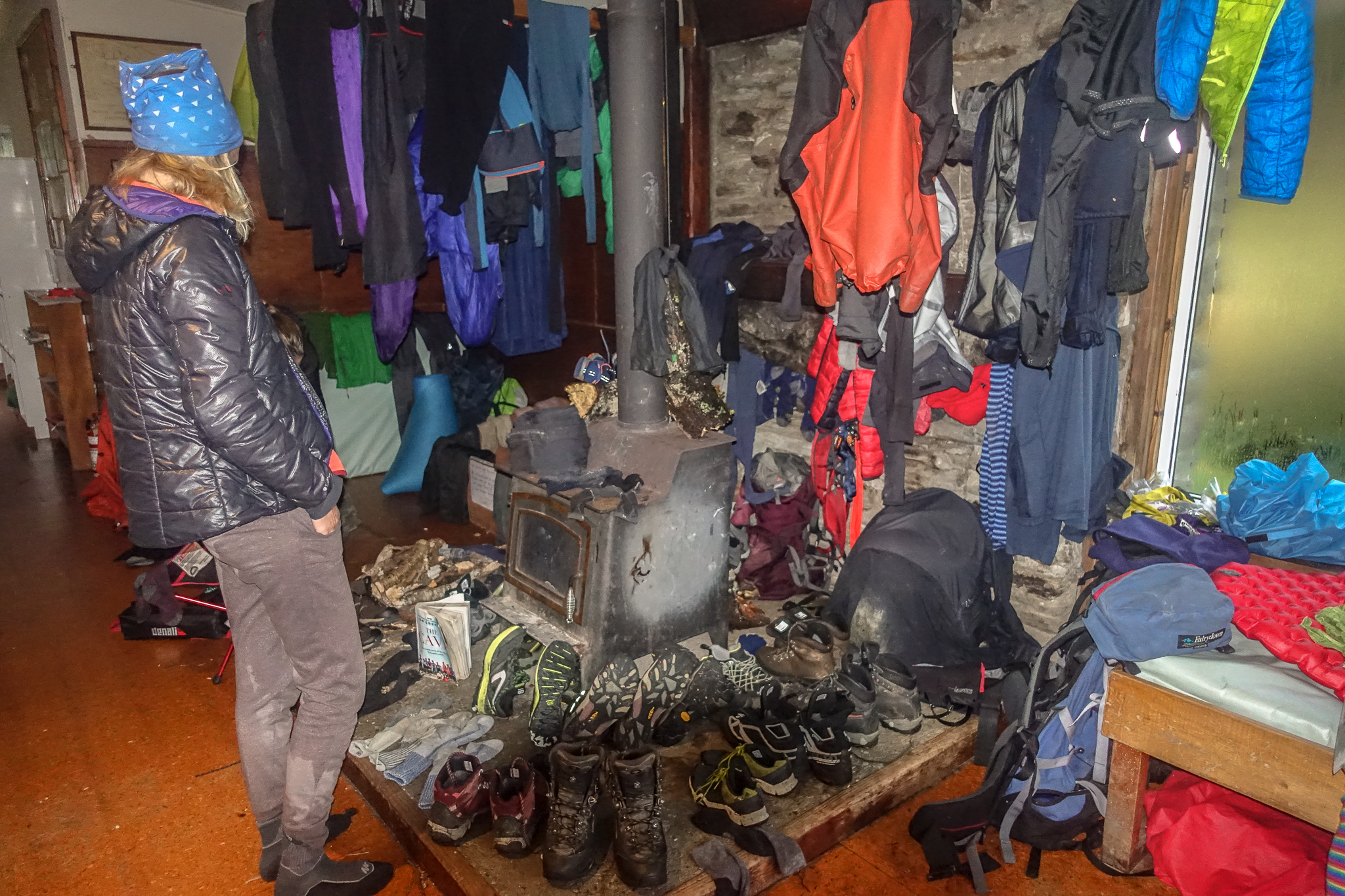
We spent a relaxing afternoon and evening at the hut, reading, having hot chocolate with Baileys (so goooood), playing cards and chatting with fellow trampers. It was luxurious being in a hut with lighting, a warm fire, free gas and flush toilets. I felt very pampered.
Day Two: Aspiring Hut – French Ridge Hut
We set off early, continuing upstream along the river flats. The weather was improved in that it wasn’t actively raining (yet). But it was still overcast enough that we didn’t feel safe doing without our parkas and pack covers. We crossed two swing-bridges over Cascade and Rough Creeks, and arrived out into the open Shovel Flat about an hour after leaving the hut.

From there it was easy flat travel through the low tussocks, with one bridged stream crossing and one unbridged ford, until we reached Pearl Flat and the swing-bridge over Liverpool stream. Here the track branches; to the left is the track up to Liverpool Hut (DOC). To the right (across the Matukituki river) is the track up to French Ridge. And straight ahead is the track to the head of the valley. Since we didn’t want to brave the icy Matukituki waters and wet our boots (that had only just started to feel dry again), we opted to walk up the valley track for another 15 or so minutes to reach the swing-bridge over the river, then back-track downstream until we reached the route up French Ridge.

Then the fun really began.
And by fun, I mean hauling our bodies and packs up the side of a mountain by tree roots.
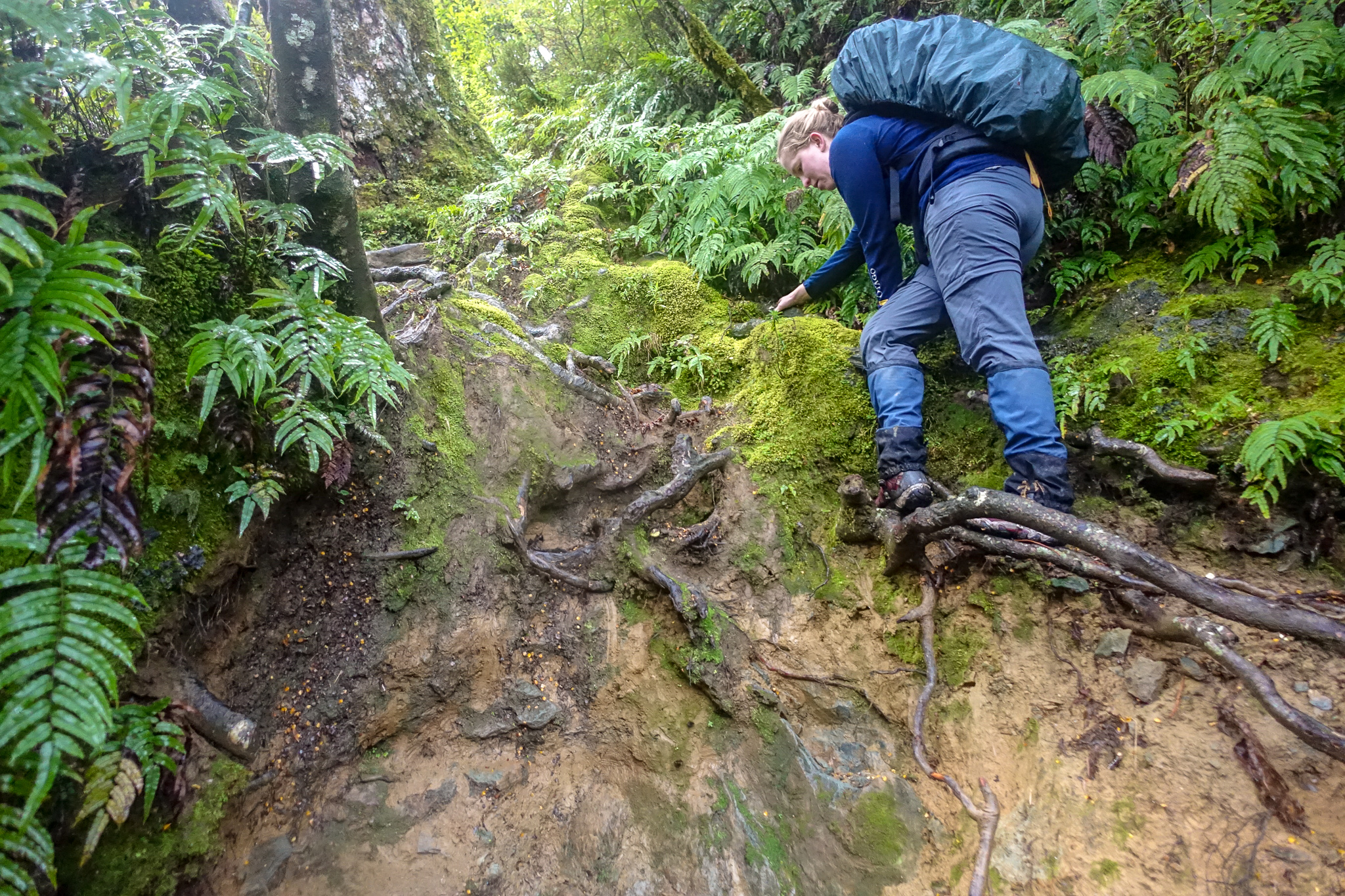
It was pretty hard going. But at least I’d prepared myself for it, having read a few trip reports and looked at the topomaps website. I knew the track had been made by climbers rather than trampers. (Read: none of this zigzagging shit, let’s cut the nonsense and just go directly up). I thought I was doing quite well, all things considered. There’d been only a few breaks and no angry yelling at tree roots or mud (albeit lots of chocolate eating).
As I’m struggling up a particularly steep, muddy section and congratulating myself on getting up this far, I hear a child’s voice floating down from somewhere above. I think tiredly that maybe the unrelenting climb has finally driven me crazy. But then a small boy appears above my head on the track. He asks cheerfully if I’d seen any Easter eggs on the track. I reply in a vague sense of bemused shock that no, I don’t think the Easter bunny makes it up this high.
The FIVE YEAR OLD boy then assures me animatedly that yes the bunny does venture into the alpine areas, since he’d found some eggs up at French Ridge Hut that morning when he woke up. His parents smile at me as they pass and remark that the keas must have stolen some of the ones that had been hidden on the deck of the hut.
I had to sit down for a while once the kid and his parents had passed us by.
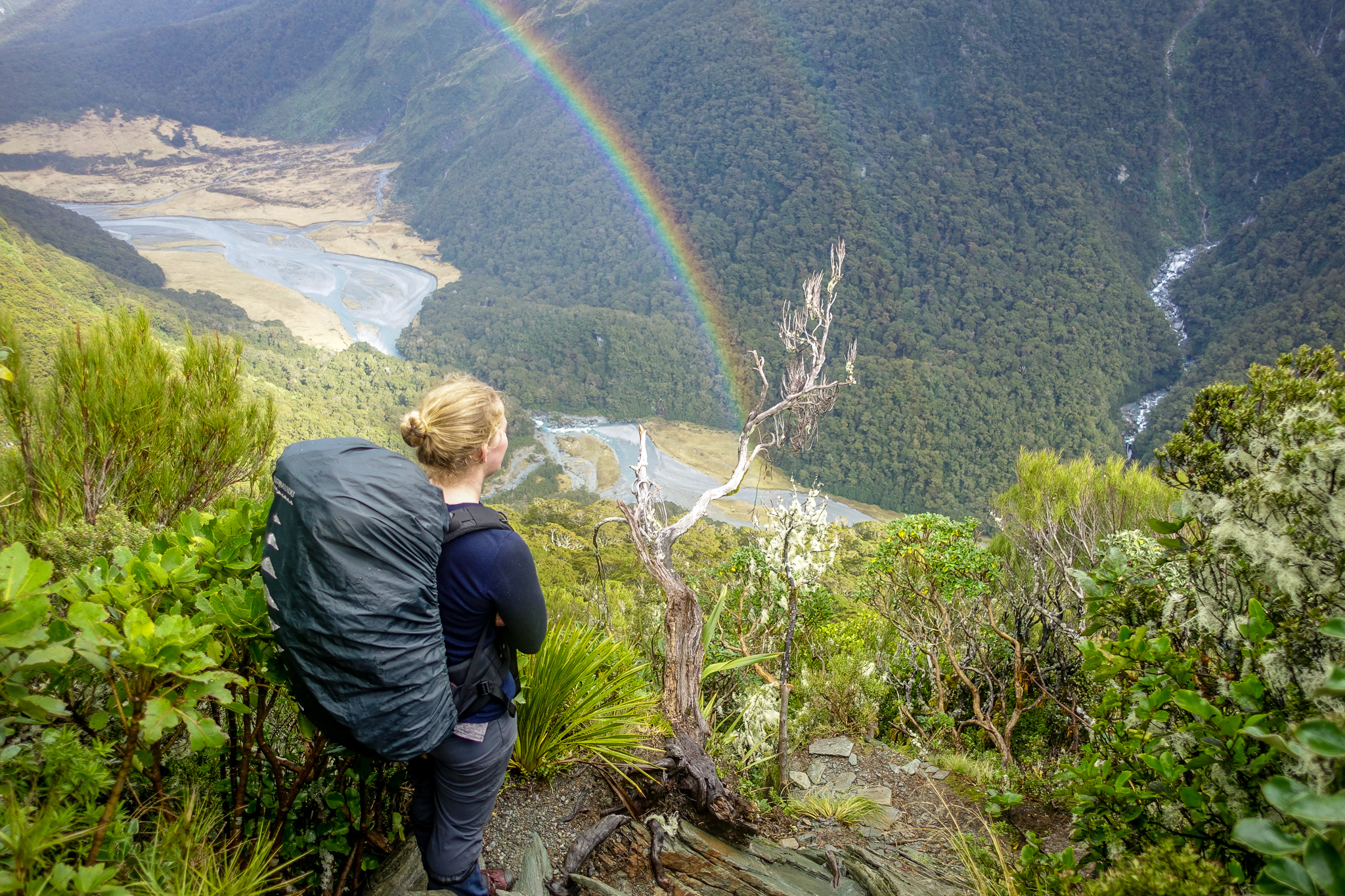
We reached the tree-line after two hours of climbing (about two thirds of the way up to the hut). The gnarliest sections being in the subalpine shrubs and low trees just before the tree-line. At some points we heard Kea and Kaka calling from nearby, which was pretty special (having been away from the South Island for over a year). From the bush-line it was a quick climb up onto French Ridge proper.
We’d been warned by a group of ladies coming down (who were wearing much more than my single long-sleeve merino) that the ridge was really exposed to the weather. Once we got up to the small tarns (and the one piece of the whole damn track that wasn’t uphill), we layered up. The wind was plucking at our pack covers and chilling our poor exposed ears.

My legs were hurting, lungs were burning, and the weather was pretty miserable, so I didn’t take any photos on the way up. These are all from the way down the next day (sorry if that’s a bit confusing).
After crossing the one flat section that the route gifted us, the track started to climb again. Or more accurately, the track turned into a small, steep clay canyon. And we laboriously climbed up the tussocks next to it.

From here, we just kept climbing. The wind pulled and pushed our bodies and packs, plucking loudly at our pack covers. I’d put on my hat and gloves along with all my wet weather gear, so I was rather warm from exertion. But my muscles were becoming a bit sluggish from fatigue and the constant climbing. I just kept telling myself “one step more”, “one step more”, over and over again, until I caught up with Dad for a quick rest. That kind of zombie-ish mentality where it’s easier to keep walking than it is to stop.

There were some interesting sections of the track, and some beautiful mountain tarns. But I didn’t really notice them at this point – just wanting to push on to the hut to rest my muscles and get into shelter. I had in my mind that the hut must be near this large rock that was pointing out from the skyline ridge. It still seemed so far away, so it was with bliss that I heard Dad call down that he could see the long-drop toilet just above us.
It was the most glorious long-drop I had ever seen.
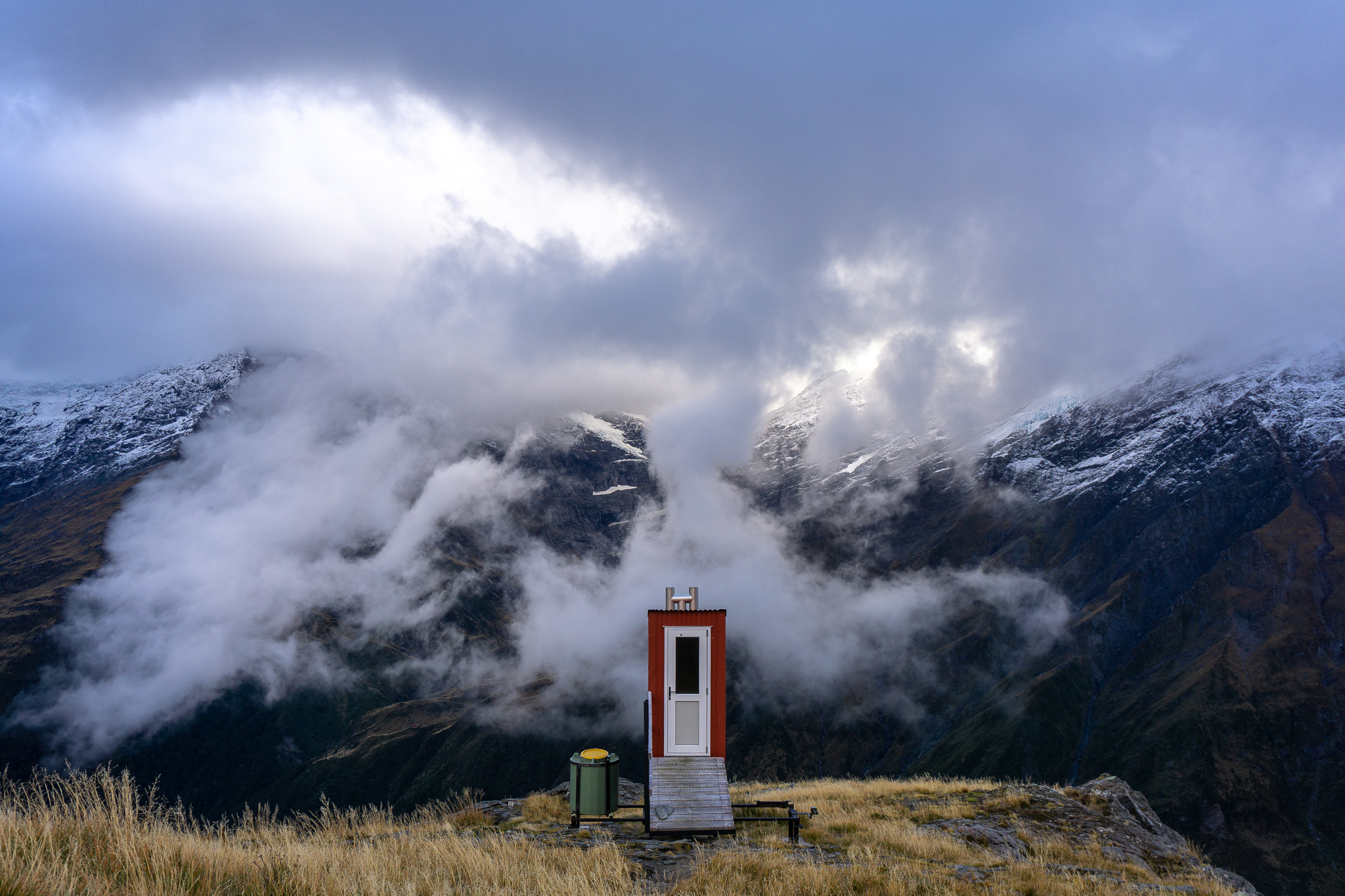
We stomped into the wet-room of the hut and shucked off our gear. (Although I left my feet to suffer in my wet socks, wanting to preserve my dry socks for sleeping in that night and then walking in the next day). We checked the bunk-room and common room – Dad and I were the first to arrive! Which meant first pick of the bunk beds. The hut was freezing (no fire) so we picked the top-most beds, knowing that with a few people in the bunk-room, it would be warmest up high.

Dad and I heated up some water (negotiating the wired-closed tap on the outdoor water tank, set up because the kea had apparently learnt how to open the tap and empty out all the water) for hot drinks (minus the Baileys this time sadly). There’s honestly nothing as delicious as a hot chocolate when you’re cold and exhausted, it tastes 10x better than normal. Scientifically proven. 9.5/10 trampers will agree.
As we warmed out hands and breathed in the hot drinks, more and more people started to slowly arrive, all varying levels of wet, cold and exhausted. The weather didn’t improve as had been promised by the forecast (surprise, surprise). So I stayed in the hut and amused myself by reading old copies of Antics, the Otago Tramping Club journal, that were sitting on the hut’s shelf (along with a 1000-piece jigsaw which became more and more tempting as the afternoon wore on).
Dad had wanted to go exploring up the ridge further and look out on the Quarterdeck; the ice-fall access onto the Bonar Glacier and on to Colin Todd Hut and Mt Aspiring, but the weather limited how far he got. I hopped out for a bit too to take some photos with the beautifully moody sunset. But quickly returned to the (relative) warmth of the hut and to chat with the other trampers who had arrived.
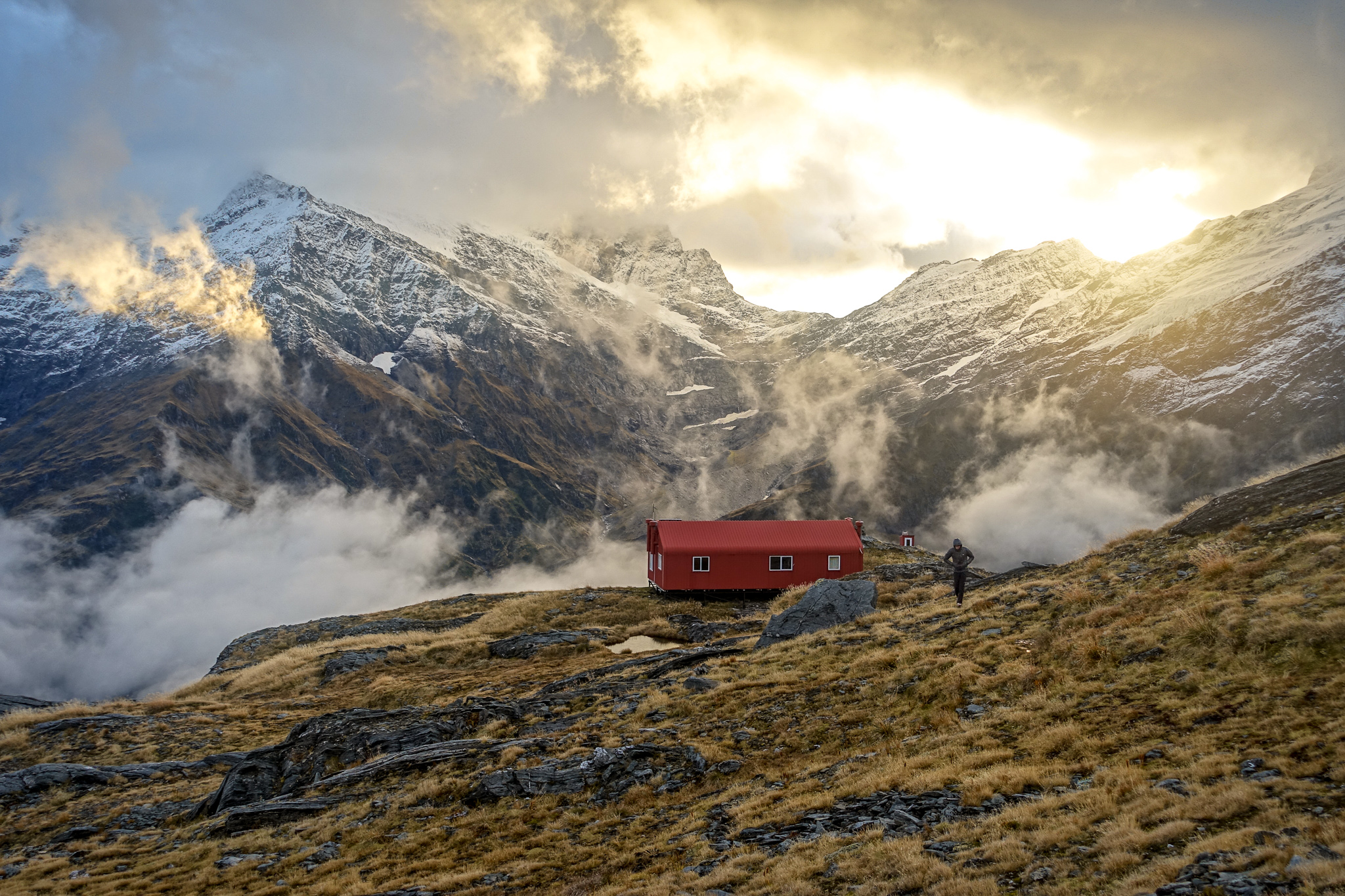
Dad and I cooked up our Back Country Cuisine freeze-dried meal and dessert for dinner (apple pie review = delicious). At 7.45pm we had the mountain radio call from the warden down in Aspiring Hut. We reported an overly full hut (22 people) and uninspiring weather. But the warden was able to tell us that it was meant to clear overnight. I took this with a healthy dose of skepticism, still recovering from the day’s wet weather betrayal.
I’d worried about being cold overnight, but with a crowded hut, this was a non-issue. I ended up sleeping in only one layer of merino and my sleeping bag half open. And my ear plugs firmly placed. No snorers for me.
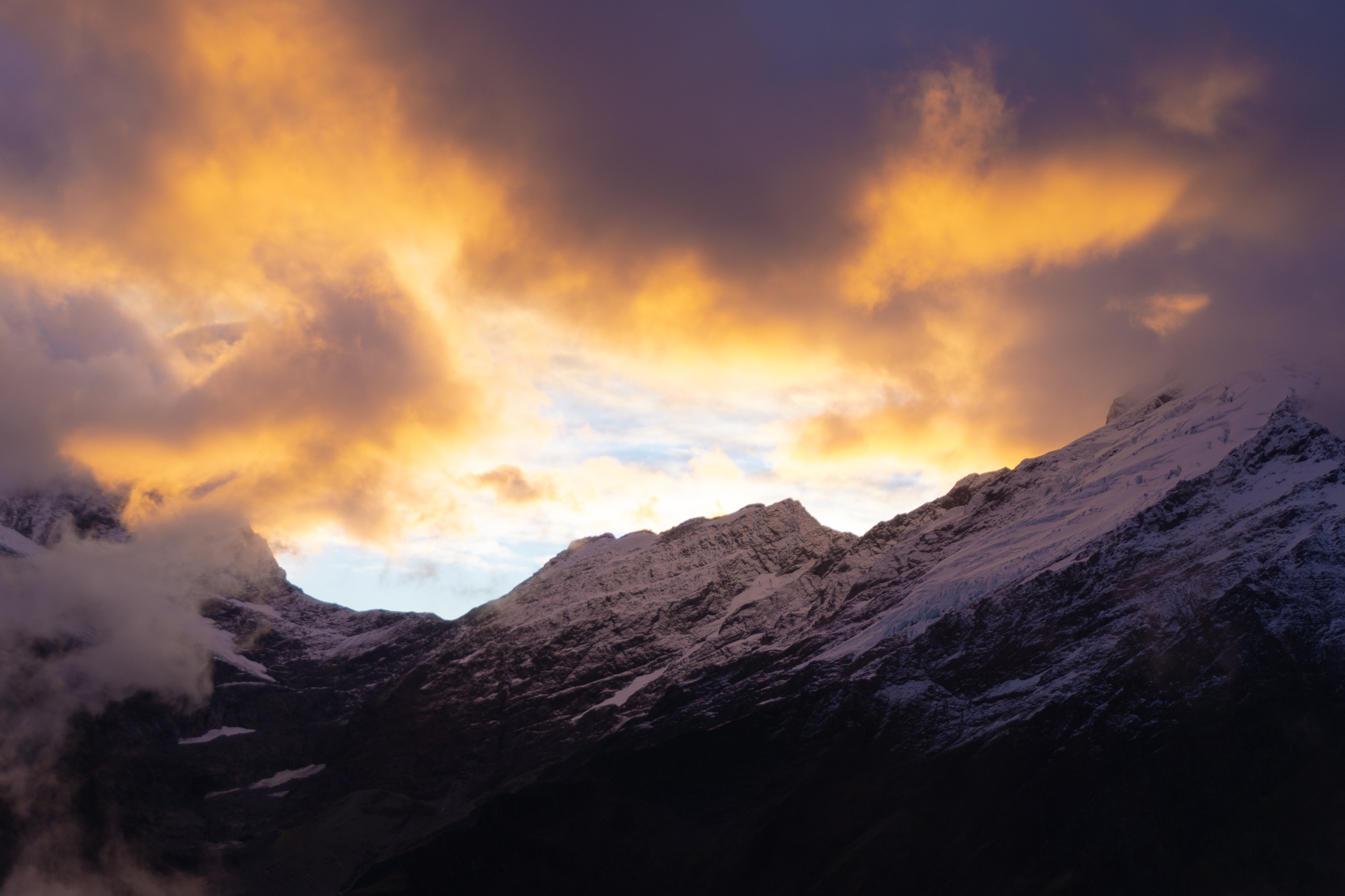
Day Three: French Ridge Hut – back to the carpark
After a surprisingly warm night, we woke up to a dark, but CLEAR sky with sparkling stars far above. The forecast had came through!
Neither Dad nor myself was in a hurry to start the long trip back down. So we had breakfast and wandered around for a bit enjoying the view, which was so drastically changed from the day before. The tussocks were white, frozen stiff, and the rocks were slick with a layer of ice. But I had a hard time paying attention to my footing with such a beautiful vista in front of me in the dawn light.


Eventually however it was time to set off, with a Kea laughing at us from the top of the chimney (not everyone can fly down mate!). Needless to say, I enjoyed this much more than the day prior. Despite my boots rubbing around my toes and knowing that blisters were likely forming. (I’d tried taping them up at the hut, but we didn’t have any blister wool). The weather was fantastic (one of three days ain’t bad, eh Meatloaf?). And the mountains surrounding us were entirely clear of cloud. A great day to be up in the mountains.
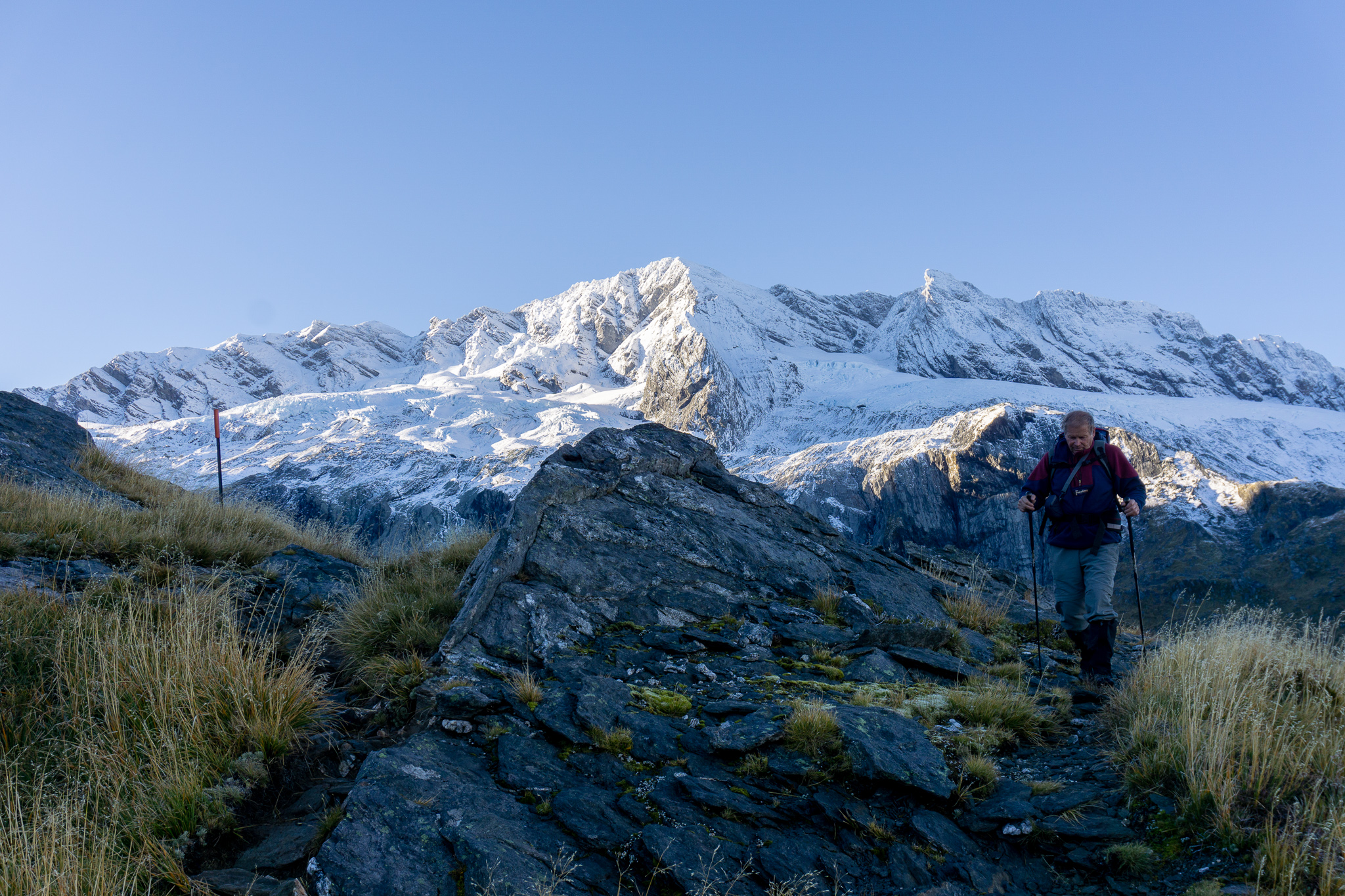
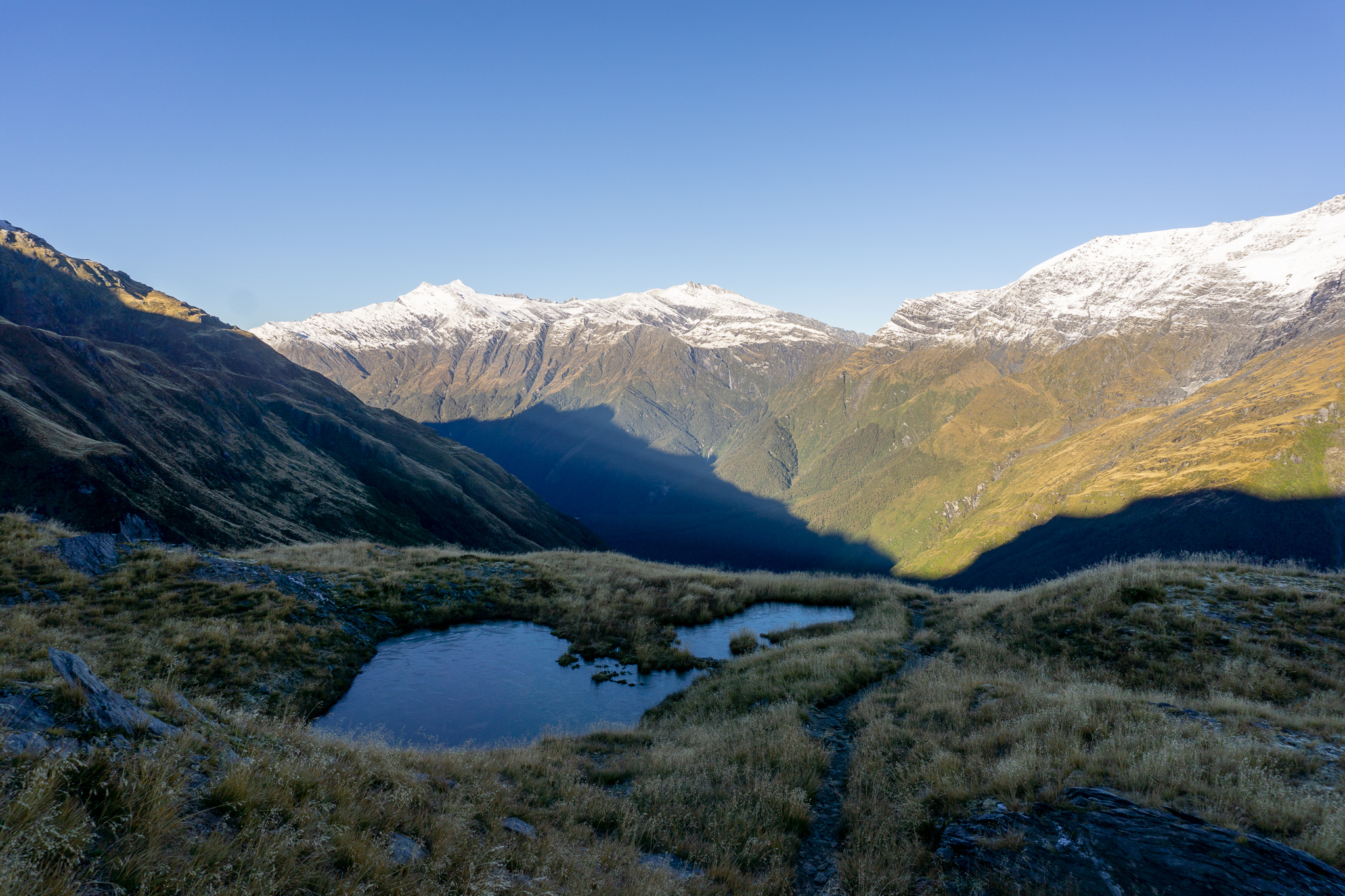
The group of tarns marking the (almost) edge of the tree-line came into view below us, looking far, far away. No wonder it had felt so long on the way up the day before! The drop-offs also seemed a lot more exposed, despite not having any wind trying to push us over the edge this time. But the views were amazing as the sun rose and highlighted different parts of the mountain and valleys.
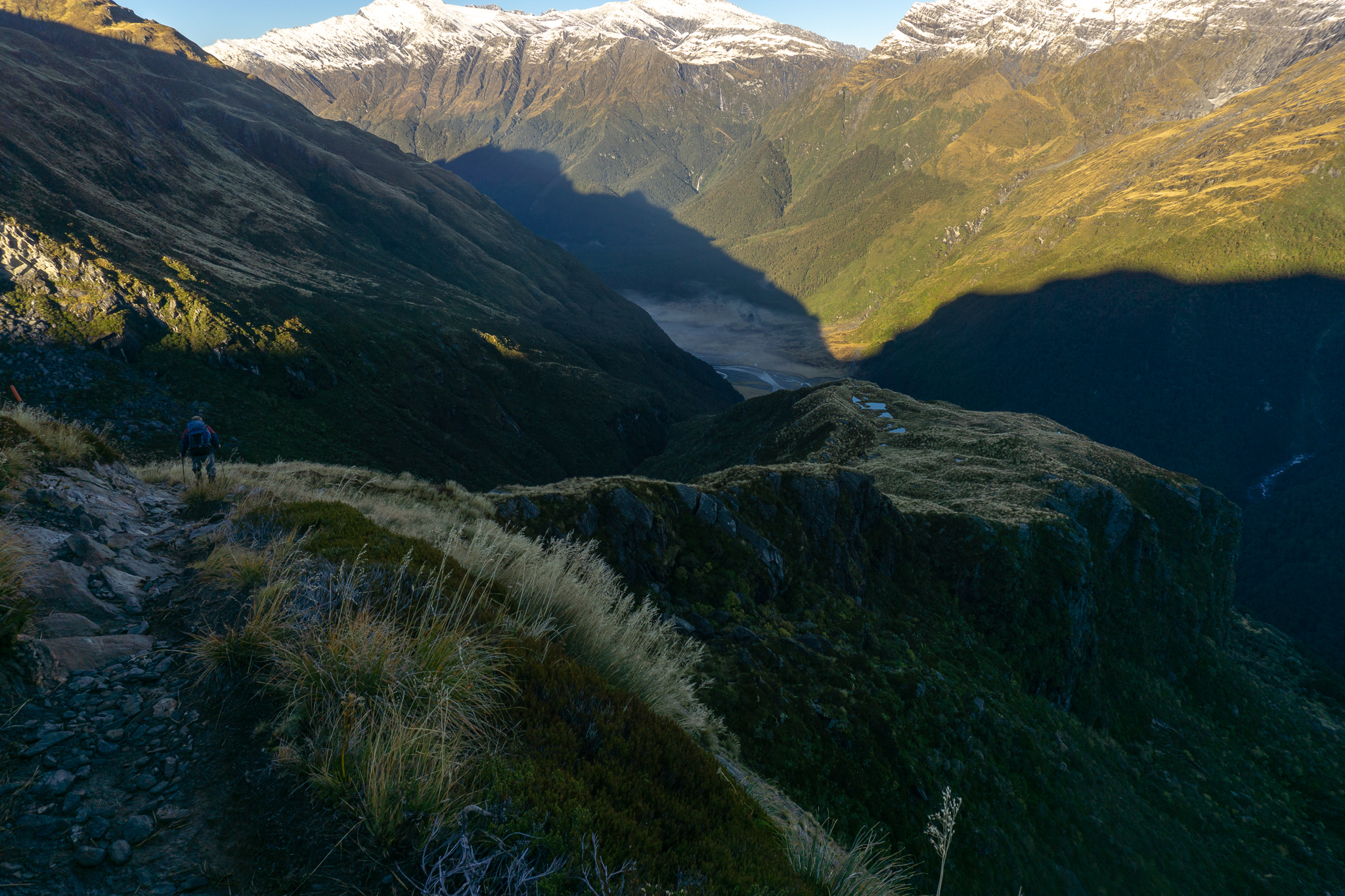
Although it seemed like a large distance, it wasn’t too long before we were down at the tarns (the mountains casting perfect reflections in their still waters), and then the bush-line. Here we had to tackle the more interesting parts of the “track” backwards, which felt more like “abseiling with tree roots”, as opposed to “tramping”. I made it down with only one fall (falling down some steep tree roots on my ass and somehow landing on my nose, fun times).
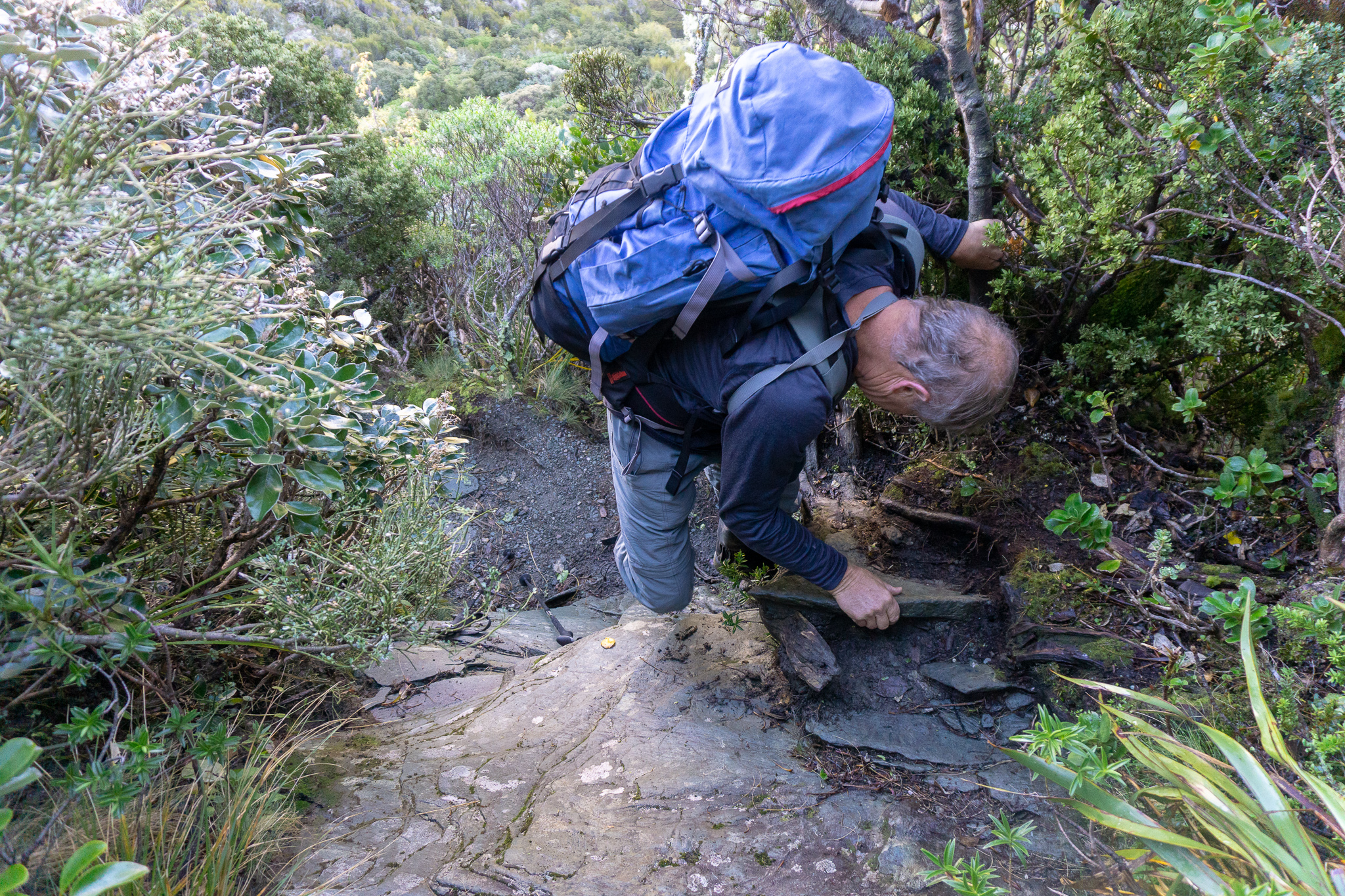
My legs were trembling by the time we made it back down to Pearl Flat. It had taken us almost as long to get down as it had to go up the day before, showing just how steep the track up to French Ridge Hut really is. It had definitely felt like just as much effort to get down as it had to climb up. I was so glad when the Matukituki finally came into view (rather than teasing us through tree branches for the last 30 minutes of the descent).
Instead of taking 20 minutes to detour up to the swing-bridge, I was quite keen to just ford the river. We braved the swarming sandflies and took off our almost-dry boots and dry socks, popped on our still wet socks from the day before (to protect poor toes) and crossed over. The water was just as icy as it had looked. But the main hazard wasn’t the temperature or flow of the water (or stubbing toes/twisting ankles on rocks). It was the sandflies. I swear I probably ingested a few of them, as they flew around my face and body, seeking skin. It made me a bit queasy wondering who else they’d bitten before they wound up in my stomach. I couldn’t walk through the river fast enough to lose them.
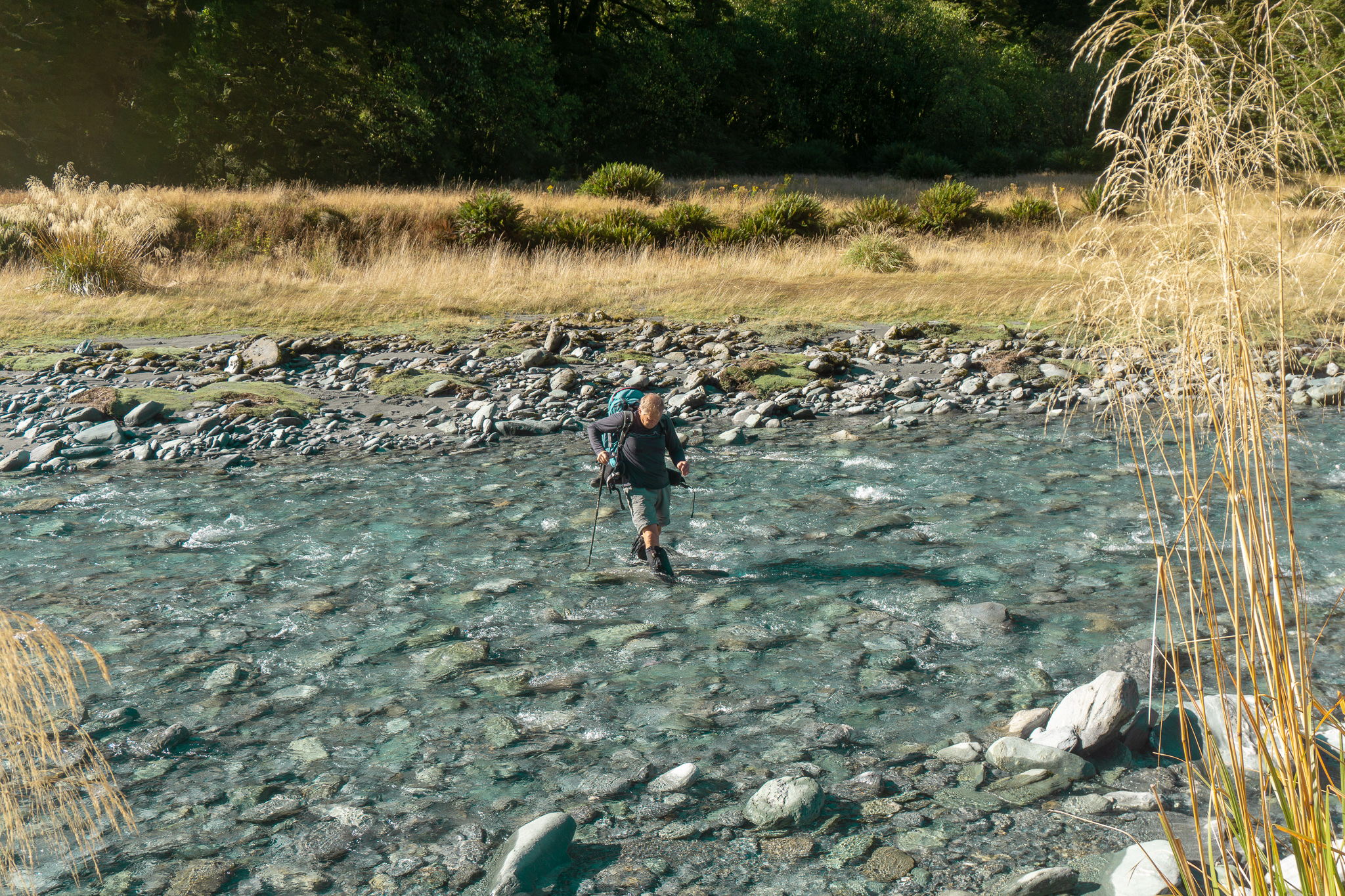
I put my boots and gaiters back on in world record time. Sandflies are the worst.
I waited in the shade next to the Liverpool Stream swing-bridge for Dad to leisurely put his own socks, boots and gaiters back on. (He was benefitting from the strategy I normally use when it comes to sandflies; bring along someone whose blood is more attractive to them than yours. Unfortunately in this instance: dat me). Sandflies love the sun (so why they live in the South Island, let alone New Zealand is beyond me … ). And I tricked them (for a while) by keeping to the shadows.

The climber who’d been drying his gear at Aspiring Hut had told us about seeing a cat up towards Bevan Col, which I was really surprised by (knowing full well the threat to our native wildlife from introduced species like stoats, rats, possums, etc., but not realising that feral cats could be found in these types of remote areas too). So it was to even more surprise that out of the corner of my eye, I saw a largish (for New Zealand wildlife) shape moving through the tussocks on Pearl Flat between myself and Dad, still sitting on the gravel next to the river putting his boots on. It was the cat!
I alerted Dad, who tried to sneak up on it. But it was too quick (although it didn’t look too healthy), and dodged back into the bushes. The ranger was out up Cascade Saddle when we made it to Aspiring Hut, but we let the DOC workers who were checking traplines know instead. Apparently they’d set cat traps around the hut (rather than up the valley since they need checked daily). And they’d caught 12 cats in the west Matukituki Valley alone this season! It made me appreciate their work and the native birdsong even more.

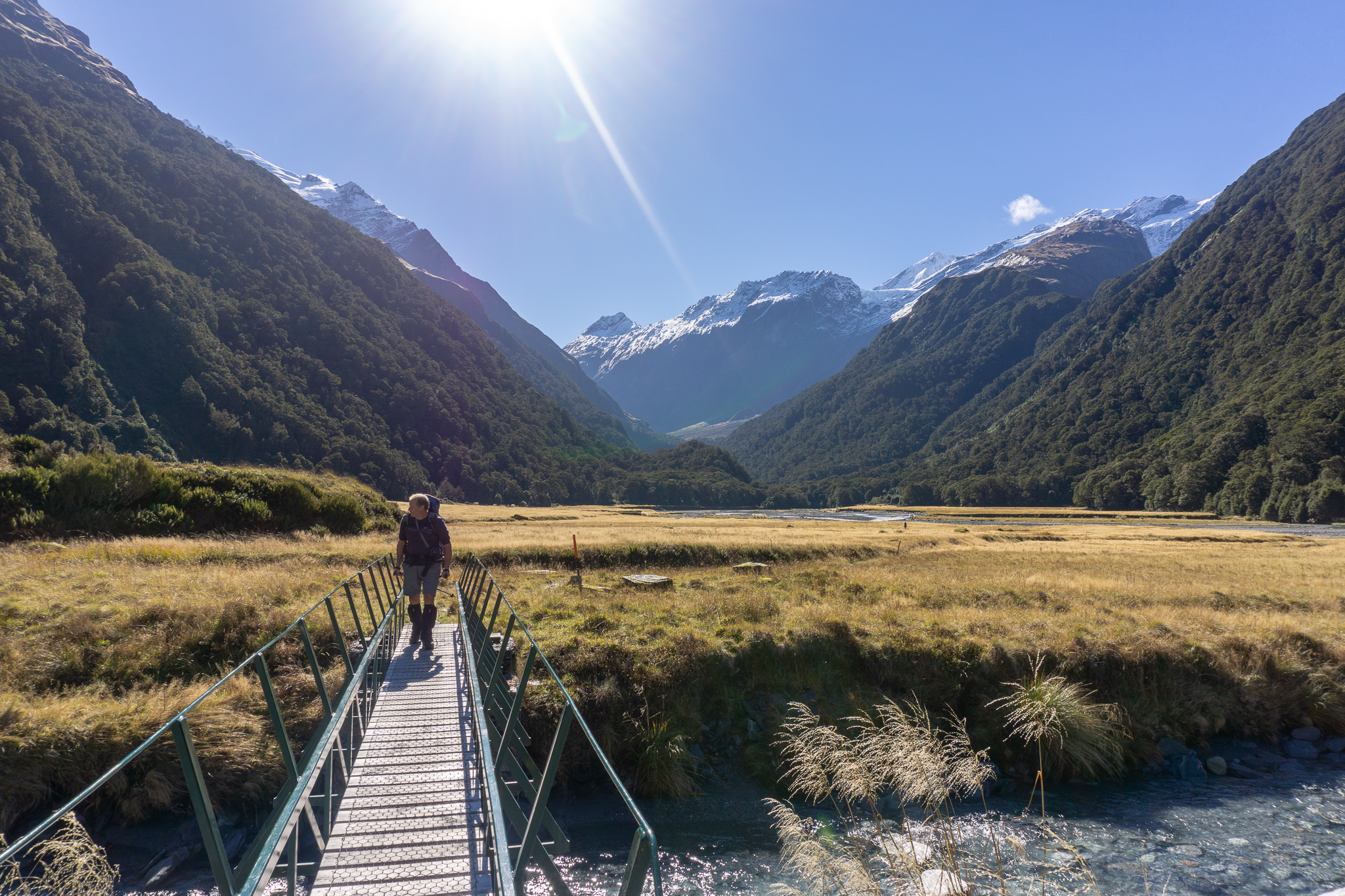
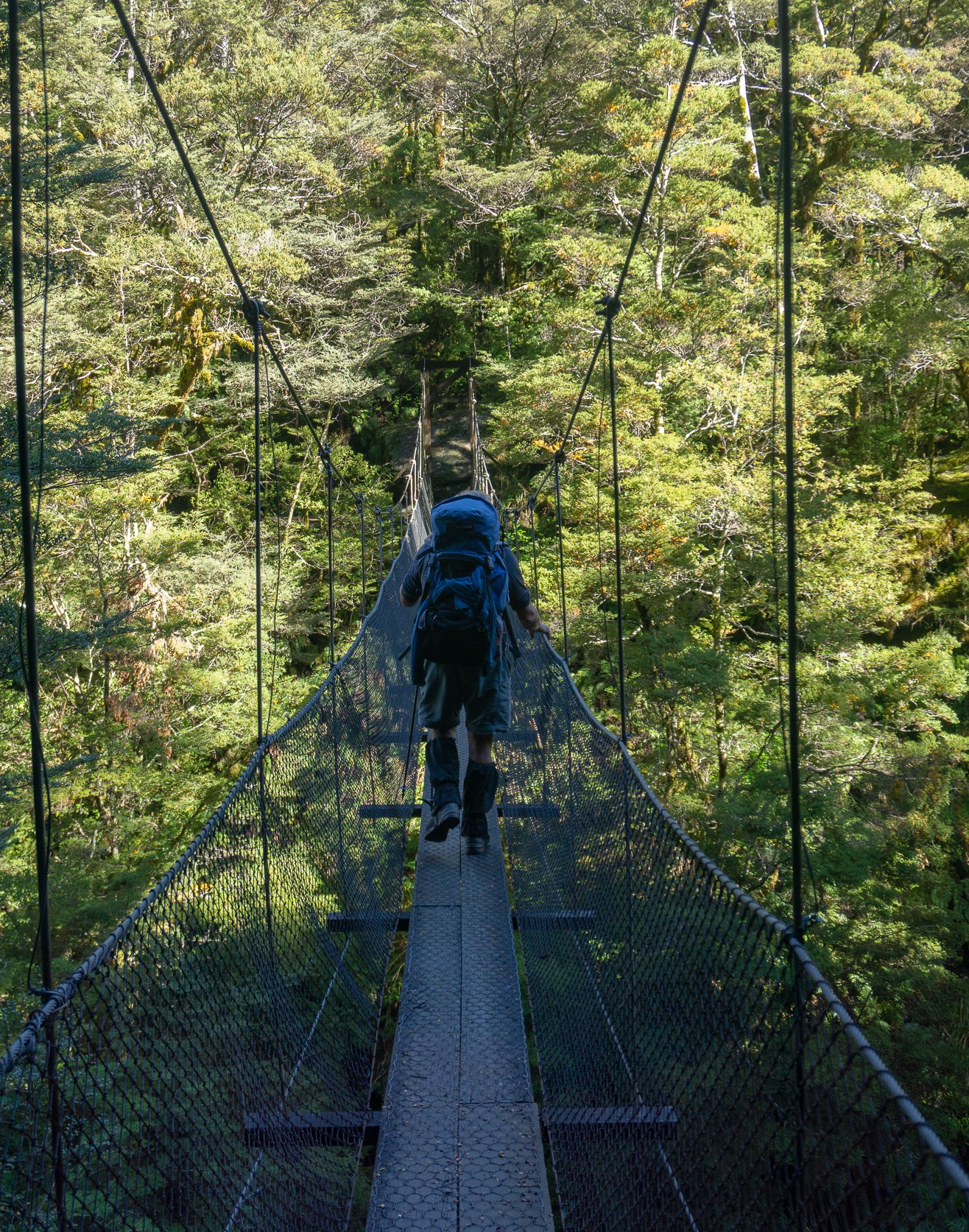
We made it back to Aspiring Hut and I pulled off my boots and socks to see that yes, somehow the lower knuckle of my second little toe had blistered, and the nail on my little toe wasn’t looking too healthy. I’m still not entirely sure why it took day three of the tramp to blister and in such an odd place, maybe my new socks that I’ve slavishly tried to keep clean and dry? In any case, once you’ve got a blister, there’s not too much that can be done (prevention is key!). It was still relatively small so I just re-taped it, not worrying overly much since this was the last day of the trip.
Dad and I cooked up our emergency freeze-dried meal for lunch rather than our crackers with salmon or cheese (hot lunch > cold lunch) and chatted with some of the Milton Rotary Group, who were on their big annual tramping trip.
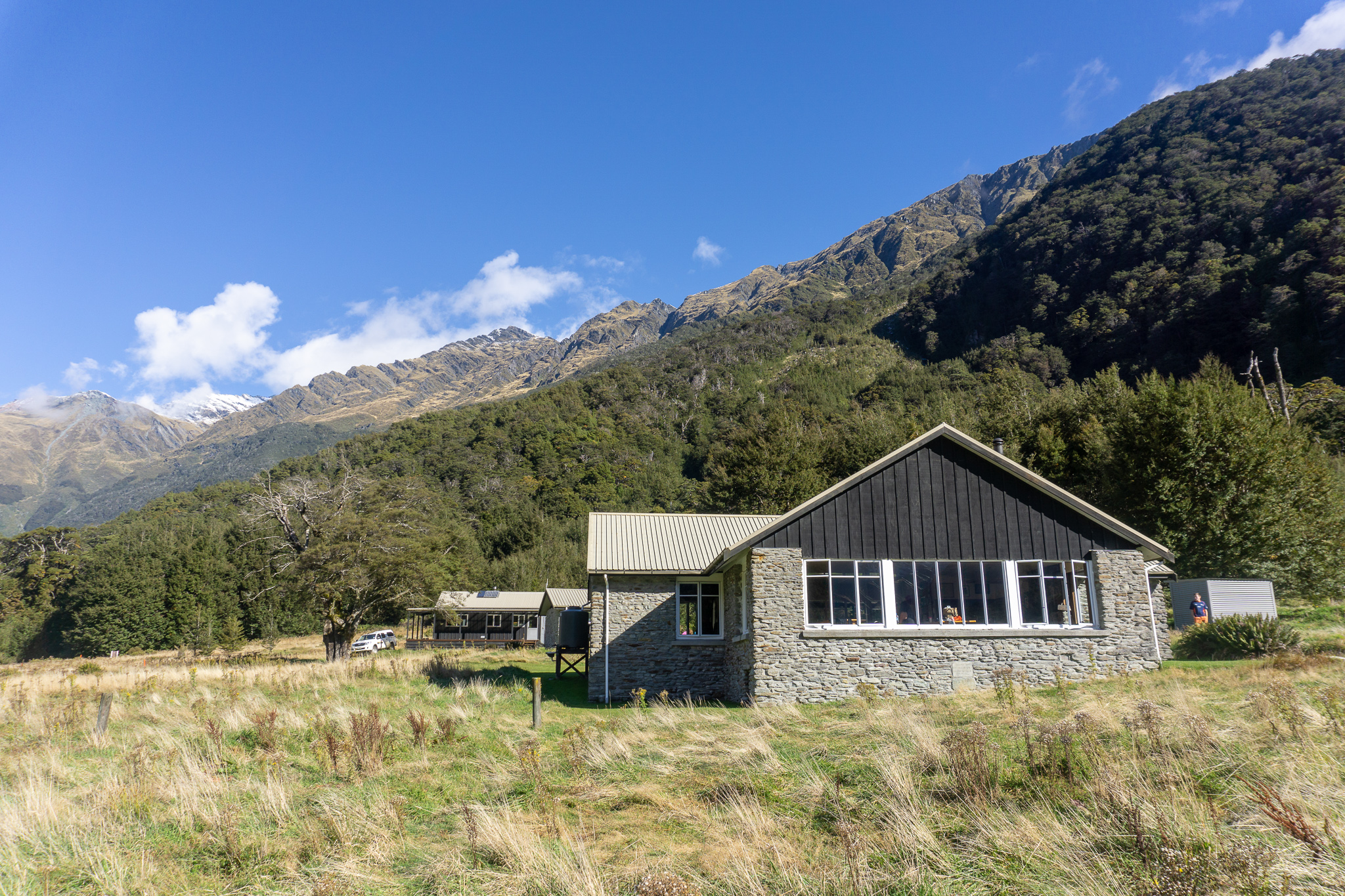
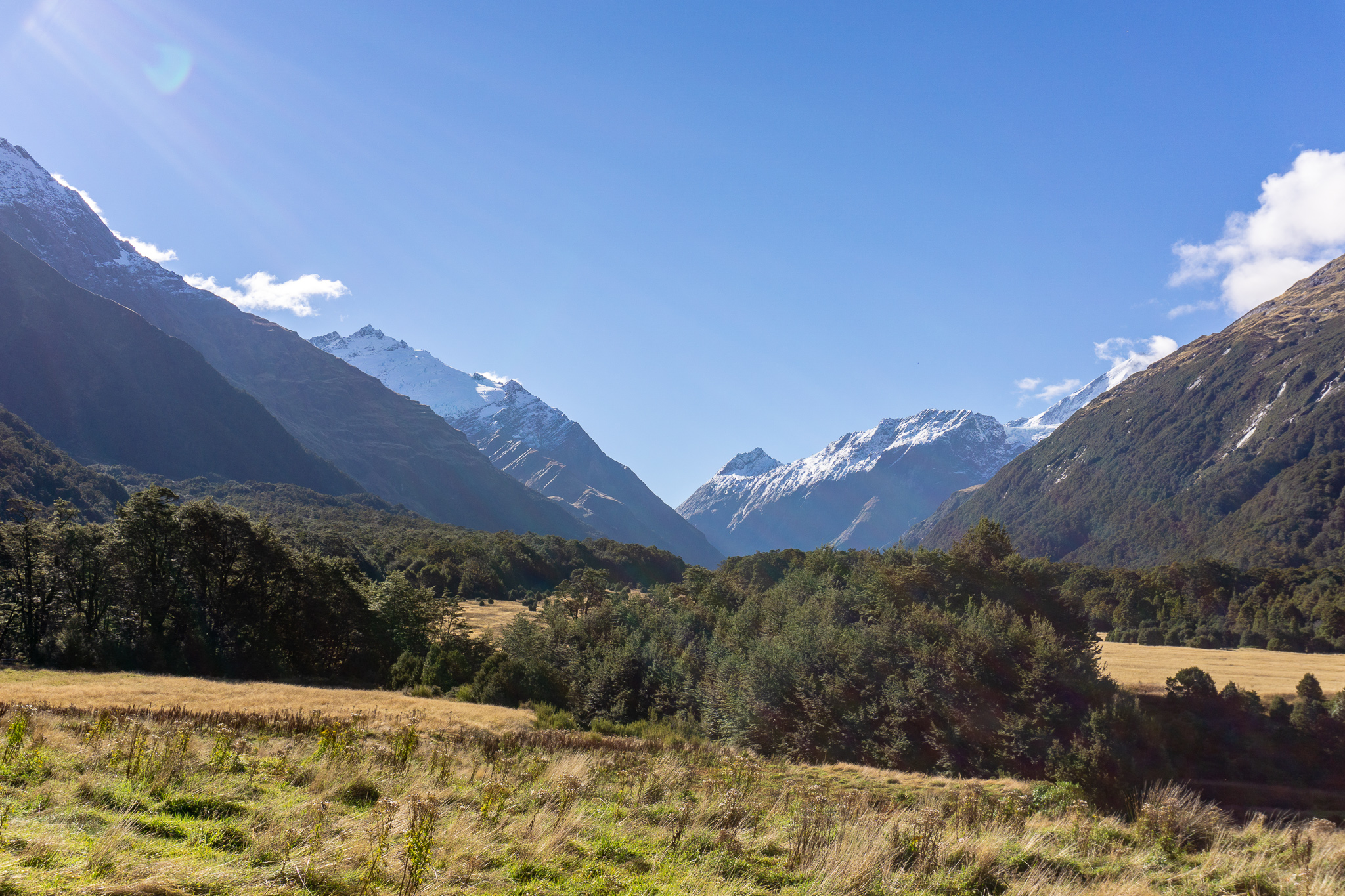
Then it was the homeward stretch. After alerting the DOC workers to the cat and ascertaining that no, we couldn’t hitch a ride on their truck since they wouldn’t be leaving for another few hours (one can only hope), we started on our way. The ground was still pretty soft and occasionally squelchy from the rain the last two days, but it didn’t feel like we were walking through a swamp, which had kind of been the impression I’d had on the way in. The soft ground was kinder to Dad’s feet, as he has issues with his arches that bother him on hard, flat ground.

The sun was shining, but the air was still relatively cool, so we took our time and a lot more breaks that on our way in. There were a lot of people on the track/4WD road (I’d counted over 20 going past us before we reached Aspiring Hut and had let a few of them know that if they were headed for French Ridge Hut, that they better be prepared to sleep on the floor). It was nice to see so many people getting out and about to enjoy the great outdoors in such good weather on an extra long weekend, but I also selfishly wished that it was less busy. It definitely detracted from the overall experience – normally one doesn’t go out of their way to isolate themselves in the wilderness just to be surrounded by people.


My legs were getting pretty tired, and the blister very much making itself felt, by the time we climbed the last little uphill section and saw the carpark. When I looked back, there was what seemed like a whole line of people on the track (we’d left the hut earlier than most, and they were only just catching up to us now). The carpark was also much busier, with cars parked up the road and beyond the last ford.
I changed into my spare change of clothes and loose shoes (such a good feeling), and we hit the road. We drove out of the Matukituki Valley as the sun set, satisfied and content. The trip into French Ridge Hut was an amazing place to spend a long weekend. I can’t wait to get back into the area. Anyone want to climb Cascade Saddle with me?
Safety
As always, please stay safe when you’re out exploring. Follow the Outdoor Safety Code:
- Choose the right trip for you (read my article, talk to DOC, look at Topomaps, read other blogs!)
- Understand the weather
- Pack warm clothes and extra food (my gear list is below or you check out my post on what to taking tramping here)
- Share your plans and take ways to get help (have an emergency beacon on your person)
- Take care of yourself and each other
This is a trip into alpine areas – do not underestimate the conditions and stay within your level of experience and comfort. Weather conditions will change your trip drastically, ensure you know the weather forecast and adjust your plans accordingly before setting out.
Stay safe and get outside!
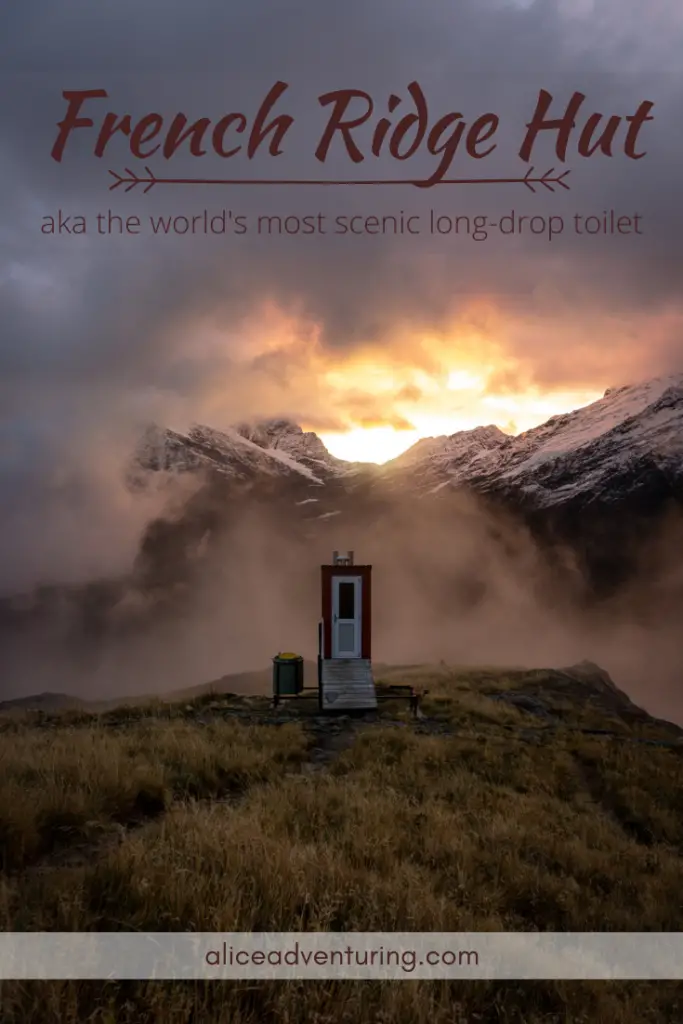

Gear List
For more info on tramping gear – check out my comprehensive blog post here.
Clothes:
- Warm hat
- Neck gaiter/buff
- Sports bra
- 3x moisture-wicking singlets
- 2x long-sleeve merino tops
- Fleece jersey with hood
- Puffer jacket
- Gloves
- Rain- and wind-proof jacket
- 3x underwear
- 3x woollen socks
- Pair of merino tights
- Fleece pants
- Rain- and wind-proof overtrousers
- Gaiters
- Boots
Gear:
- Sleeping bag + liner + inflatable pillow (soft, I know)
- Lightweight bowl + spoon + cup with mL measurements
- Billy + cooker + gas + matches
- 1x 2L water bottle and 1x 750ml water bottle
- First aid kit
- Personal locator beacon
- Head torch + solar lantern
- Cards
- Toiletries: deodorant, toothbrush, toothpaste, moisturiser, sunblock and chapstick (insect repellant would have been handy for the last day too)
- Dry bags to hold and compartmentalise gear
Food:
- Porridge + milk powder for breakfasts
- Chocolate
- Crackers + soft cheese + cans of salmon for lunches
- 3x Back Country Cuisine meals + 1x dessert (Apple Pie is delicious!) for dinners
- Hot chocolate sachets (and small bottle of Baileys to go with)
- Lots of OSM bars
- Chocolate
- Fruit puree pouches
- Bliss balls
- Chocolate
- Werther’s Originals
- Scroggin
- Banana + mandarin
- Chocolate

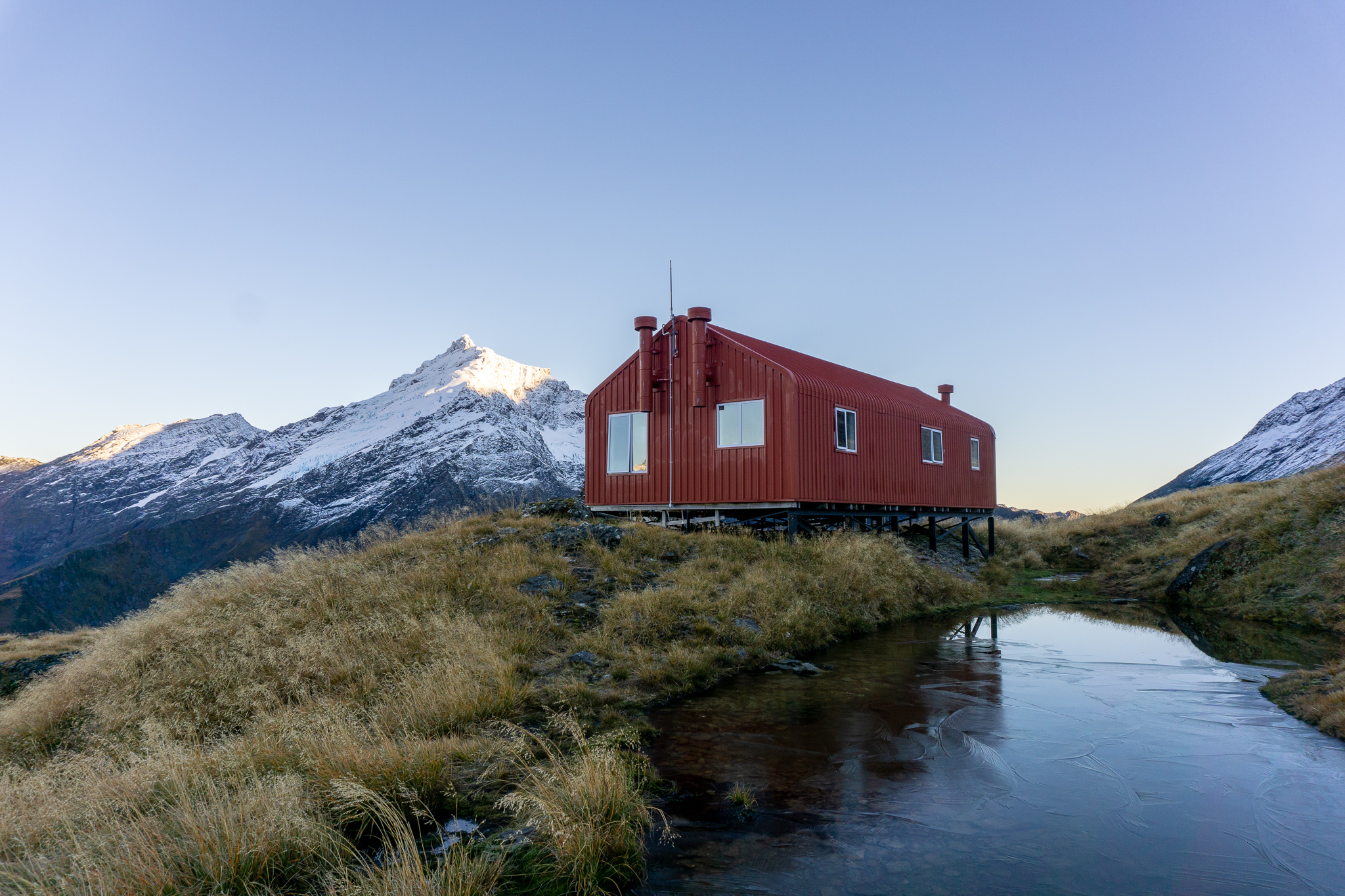
Brilliant Alice
You are very funny, you had me laughing my head off at times. I think you like chocolate as much as my wife. I can let a Easter Egg sit on the bench for months 😂🤣 very interesting and informative thanks. I have this on my todo list as a very long day hike, as I snore like a chainsaw 🤣 but I think I will leave for late spring now. Thanks again
Thanks Willy! Yeah, there’s no way I would let Easter chocolate sit on the bench more than a day … I would love to return to Angelus with the snow, I’ve seen photos and it just looks magical! Let me know how it goes